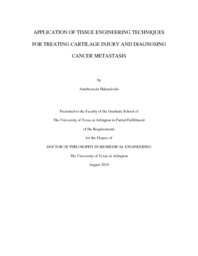
ATTENTION: The works hosted here are being migrated to a new repository that will consolidate resources, improve discoverability, and better show UTA's research impact on the global community. We will update authors as the migration progresses. Please see MavMatrix for more information.
Show simple item record
| dc.contributor.advisor | Tang, Liping | |
| dc.creator | Hakamivala, Amirhossein | |
| dc.date.accessioned | 2022-01-20T17:33:25Z | |
| dc.date.available | 2022-01-20T17:33:25Z | |
| dc.date.created | 2019-08 | |
| dc.date.issued | 2019-08-05 | |
| dc.date.submitted | August 2019 | |
| dc.identifier.uri | http://hdl.handle.net/10106/30131 | |
| dc.description.abstract | This study focuses on the application of tissue engineering techniques for the diagnosis of cancer metastasis, cartilage regeneration, and modeling of lymph node metastasis.
Chapter 1 is an overview of tissue engineering strategies, and it describes how each chapter relates to the central theme.
Chapter 2 describes the development of 3D lymph node (LN) mimetic for studying prostate cancer metastasis. The overall objective of this chapter was to develop a biosystem with the ability to mimic metastatic LN condition. Studies were first designed to uncover the critical cells types and chemokines responsible for cancer metastasis to the LNs. An LN cell-seeded (also called as LN mimetic) device was developed and tested on its ability to mimic real metastatic lymph node. The results show that it can simulate the metastatic LN microenvironment. The device can be used to distinguish the highly metastatic cancer cells from low metastatic ones and can also provide a powerful tool to investigate the processes governing LN metastasis.
Chapter 3 illustrates our work on the establishment of a metastatic LN construct. While LN mimetic was designed for in vitro studies, it cannot be used for studying LN metastasis in vivo. LN construct was fabricated for in vivo study by encapsulating combination T cells and cancer cells in alginate microbeads. The physical, chemical and biological properties of the microbeads were determined. The ability of these microbeads to induce PCa metastasis was first evaluated in vitro. Finally, the ability of metastatic LN construct to promote tumor cell recruitment and to reduce LN metastasis was assessed in vivo. Our results confirmed that the LN construct could create microenvironment resembling metastatic LNs. Such a device can be used as a unique tool to investigate how cancer:LN cells interaction lead to cancer LN metastasis.
Chapter 4 depicts the establishment of a new treatment for cartilage injury by applying an in situ tissue engineering approach. The goal was to develop a platform technology for regenerating injured cartilage by restoring its intrinsic chondrogenic capacity via directed endogenous progenitor cells responses following simple intra-articular injection. Using a rabbit model of full-thickness cartilage-defect, we found that erythropoietin (Epo)-loaded-hyaluronic acid (HA) microscaffolds were able to trigger endogenous progenitor cells recruitment, reduce inflammatory responses in the synovial space and facilitate cartilage defect repair.
In conclusion, these studies explore the potential of using various tissue engineering techniques on the development of various diagnosis and treatment devices for different life-treating pathological events. | |
| dc.format.mimetype | application/pdf | |
| dc.language.iso | en_US | |
| dc.subject | Tissue engineering | |
| dc.subject | Diagnosis | |
| dc.subject | Cancer metastasis | |
| dc.subject | Metastatic lymph node | |
| dc.subject | Cartilage regeneration | |
| dc.title | APPLICATION OF TISSUE ENGINEERING TECHNIQUES FOR TREATING CARTILAGE INJURY AND DIAGNOSING CANCER METASTASIS | |
| dc.type | Thesis | |
| dc.degree.department | Bioengineering | |
| dc.degree.name | Doctor of Philosophy in Biomedical Engineering | |
| dc.date.updated | 2022-01-20T17:33:26Z | |
| thesis.degree.department | Bioengineering | |
| thesis.degree.grantor | The University of Texas at Arlington | |
| thesis.degree.level | Doctoral | |
| thesis.degree.name | Doctor of Philosophy in Biomedical Engineering | |
| dc.type.material | text | |
| dc.creator.orcid | 0000-0001-7883-0993 | |
Files in this item
- Name:
- HAKAMIVALA-DISSERTATION-2019.pdf
- Size:
- 5.219Mb
- Format:
- PDF
This item appears in the following Collection(s)
Show simple item record


